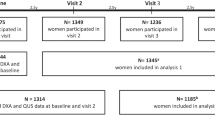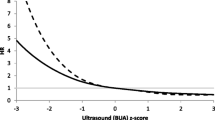Abstract
Osteoporosis is a highly prevalent but preventable disease and, as such, it is important that there are appropriate diagnostic criteria to identify those at risk of low trauma fracture. In 1994 the World Health Organization (WHO) introduced definitions of osteoporosis and osteopenia using T-scores, which identified 30% of all Caucasian post-menopausal women as having osteoporosis. However, the use of the WHO T-score thresholds of −2.5 for osteoporosis and −1.0 for osteopenia may be inappropriate at skeletal sites other than the spine, hip and forearm or when other modalities, such as quantitative ultrasound (QUS) are used. The aim of this study was to evaluate the age-dependence of T-scores for speed of sound (SOS) measurements at the radius, tibia, phalanx and metatarsal by use of the Sunlight Omnisense, to evaluate the prevalence of osteoporosis and osteopenia at these sites by use of the WHO criteria, and calculate appropriate equivalent T-score thresholds. The study population consisted of 278 healthy pre-menopausal women, 194 healthy post-menopausal women and 115 women with atraumatic vertebral fractures. All women had SOS measurements at the radius, tibia, phalanx and metatarsal and bone mineral density (BMD) measurements at the lumbar spine and hip. A group of healthy pre-menopausal women aged 20–40 years from the pre-menopausal group were used to estimate the population mean and SD for each of the SOS and BMD measurement sites. Healthy post-menopausal women were classified into normal, osteopenic or osteoporotic, based upon the standard WHO definition of osteoporosis and expressed as a percentage. We investigated the age-related decline in T-scores from 20–79 by stratifying the healthy subjects into 10-year age groups and calculating the mean T-score for each of these groups. Finally, we estimated appropriate T-score thresholds, using five different approaches. The prevalence of osteoporosis in the post-menopausal women aged 50 years and over ranged from 1.4 to 12.7% for SOS and 1.3 to 5.2% for BMD. The age-related decline in T-scores ranged from −0.92 to −1.80 for SOS measurements in the 60 to 69-year age group and −0.60 to −1.19 for BMD measurements in the same age group. The WHO definition was not suitable for use with SOS measurements, and revised T-score thresholds for the diagnosis of osteoporosis of −2.6, −3.0, −3.0 and −2.2 and for osteopenia of −1.4, −1.6, −2.3, and −1.4, for the radius, tibia, phalanx and metatarsal, respectively, were recommended.




Similar content being viewed by others
References
1 Anonymous WHO Study Group (1994) Assessment of fracture risk and its application to screening for post-menopausal osteoporosis. WHO, Geneva
2 Faulkner KG, Roberts LA, McClung MR (1996) Discrepancies in normative data between lunar and hologic DXA systems. Osteoporos Int 6:432–436
3 Genant HK, Grman ME, Hangartner T, et al (1995) Standardisation of measurements for assessing BMD by DXA. Calcif Tissue Int 57:469
4 Hanson J (1997) Standardisation of femur BMD. J Bone Miner Res 12:1316–1317
5 Looker AC, Wahner HW, Dunn WL, et al (1995) Proximal femur bone mineral levels of US adults. Osteoporos Int 5:389–409
6 Faulker KG, von Stetten E, Steiger P, et al (1998) Discrepancies in osteoporosis prevalence at different skeletal sites: impact on the WHO criteria. Bone 23: s194
7 Hans D, Schott A-M, Dargent-Molina P, et al (1998) Is the WHO criteria applicable to quantitative ultrasound measurement? The EPIDOS prospective study. Bone 23:s238
8 Frost ML, Blake GM, Fogelman I (2000) Can the WHO criteria for diagnosing osteoporosis be applied to calcaneal quantitative ultrasound? Osteoporos Int 11:321–330
9 Ish-Shalom S, Yaniv I, Singal C, et al (1999) Can the WHO osteoporosis criteria be applied to ultrasound measurements? 11th International Workshop on Calcified Tissues. Abstracts:34
10 Delmas PD (2000) Do we need to change the WHO definition of osteoporosis? Osteoporos Int 11:189–191
11 Barkmann R, Kantorovich E, Singal C, et al (2000) A new method for quantitative ultrasound measurements at multiple skeletal sites. J Clin Densitom 3:1–7
12 Sunlight Ultrasound Technologies Ltd (1998) Sunlight Omnisense User Manual
13 Ryan PJ, Blake GM, Fogelman I (1992) Post-menopausal screening for osteopenia. Br J Rheumatol 31:823–828
14 Knapp KM, Blake GM, Spector TD, et al (2001) Multisite quantitative ultrasound: precision, age- and menopause-related changes, fracture discrimination, and T-score equivalence with dual energy absorptiometry. Osteoporos Int 12:456–464
15 Weiss M, Ben-Shlomo A, Hagag P, et al (2000) Reference database for bone speed of sound measurements by a novel quantitative multi-site ultrasound device. Osteoporos Int 11:688–696
16 Dennison E, Eastell R, Fall CHD, et al (1999) Determinants of bone loss in elderly men and women: a prospective population-based study. Osteoporos Int 10:384–391
17 Kontulainen S, Kannus P, Haapasalo H, et al (2001) Good maintenance of exercise-induced bone gain with decreased training of female tennis and squash players: a prospective 5-year follow-up study of young and old starters and controls. J Bone Miner Res 16:195–201
18 Maddalozzo GF, Snow CM (2000) High intensity resistance training: effects on bone in older men and women. Calcif Tissue Int 66:399–404
19 Coupland CAC, Grainge MJ, Cliffe SJ, et al (2000) Occupational activity and bone mineral density in post-menopausal women in England. Osteoporos Int 11:310–315
20 Mulder JE, Michaeli D, Flaster ER, et al (2000) Comparison of bone mineral density of the phalanges, lumbar spine, hip and forearm for assessment of osteoporosis in post-menopausal women. J Clin Densitom 3:373–381
21 Gürlek A, Bayraktar M, Ariyurek M (2000) Inappropriate reference range for peak bone mineral density in dual energy X-ray absorptiometry: implications for the interpretation of T-score. Osteoporos Int 11:809–813
22 Kim K II, Han I-K, Kim H, et al (2001) How reliable is the ultrasound densitometer for community screening to diagnose osteoporosis in spine, femur and forearm? J Clin Densitom 4:159–165
23 Woodson G (2000) Dual X-ray absorptiometry T-score concordance and discordance between hip and spine measurement sites. J Clin Densitom 3:319–324
24 Melton LJ (1995) How many women have osteoporosis now? J Bone Miner Res 10:175–177
25 Looker AC, Orwell ES, Johnston CC Jr, et al (1997) Prevalence of low femoral bone density in older US adults from NHANES III. J Bone Miner Res 12:1761–1768
26 Ballard PA, Purdie DW, Langton CM, et al (1998) Prevalence of osteoporosis and related risk factors in UK women in the seventh decade: osteoporosis case finding by clinical referral criteria or predictive model? Osteoporos Int 8:535–539
27 Ahmed AIH, Ilic D, Blake GM, et al (1998) Review of 3,530 referrals for bone density measurements of spine and femur: evidence that radiographic osteopenia predicts low bone mass. Radiology 207:619–624
28 Meyer HE, Tverdal A, Falch JA, et al (2000) Factors associated with mortality after hip fracture. Osteoporos Int 11:228–232
29 National Osteoporosis Society (2001). Position statement on the use of quantitative ultrasound in the management of osteoporosis. NOS, UK
30 Ryan PJ, Spector TD, Blake GM, et al (1993) A comparison of reference bone mineral density measurements derived from two sources: referred and population based. Br J Radiol 66:1138–1141
31 Andrew T, Hart DJ, Sneider H, de Lange M, et al (2001) Are twins and singletons comparable? A study of disease-related and lifestyle characteristics in adult women. Twin Res 4:464–77
32 Black D, Nevitt M, Palermo L, et al (1993) Prediction of new vertebral deformities. J Bone Miner Res 8 [Suppl 1]:S135
33 Melton LJ (1993)Long-term fracture prediction by bone mineral assessment at different skeletal sites. J Bone Miner Res 8:1227–1233
34 Blake GM (2001) Peripheral or central densitometry: does it matter which technique we use? J Clin Densitom 4:83–96
Acknowledgements
The authors would like to thank the staff, volunteers, patients, twins, and the National Osteoporosis Society, UK for funding the study.
Author information
Authors and Affiliations
Corresponding author
Rights and permissions
About this article
Cite this article
Knapp, K.M., Blake, G.M., Spector, T.D. et al. Can the WHO definition of osteoporosis be applied to multi-site axial transmission quantitative ultrasound?. Osteoporos Int 15, 367–374 (2004). https://doi.org/10.1007/s00198-003-1555-4
Received:
Accepted:
Published:
Issue Date:
DOI: https://doi.org/10.1007/s00198-003-1555-4




